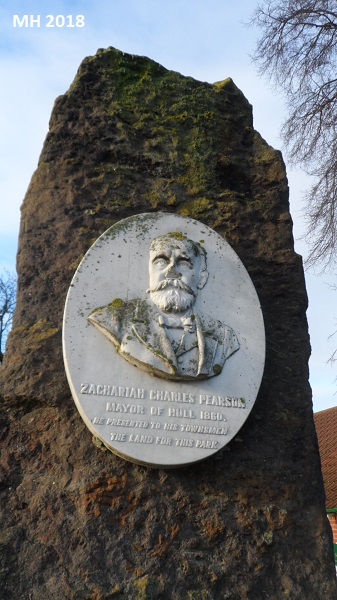

Humberside Geologist no 5
Pearson Park, originally known as the "People's Park, is a pleasant public park in the Avenues area of Hull. It has many of the features that you would expect of a park of its size; grass, trees, flowers, a children's playground, bowling greens, a lake and a "Victorian Conservatory". There are monuments too! There are the almost inevitable statues of Queen Victoria and Prince Albert, a plaque to Zacharia Pearson, Mayor of Hull, who gave the land to the City in 1860 and the cupola from the old, Town Hall, which was moved to the park in the 1930's.
As well as all these features there are two which might interest the passing geologist, especially as there is no ‘solid’ geology in Hull. In fact, considering that the Council will not support a display of the geological material in the museum this park offers the best permanent public display of local geological material in the area.

The plaque to Pearson is not mounted on a neatly finished piece of symmetrical monumental stone, as you might have expected, but is on a rough block of oolitic Cleveland Ironstone, over four metres tall. Closer examination of this block will reveal the fossilized remains of belemnites, Gryphea, Pleuromya, Pinna (?) and a terebratulid brachiopod. Pieces of fossilized wood and burrows can also be seen.
The lake, with its overhanging trees and numerous ducks, is edged with a varied collection of boulders. Geologically these seem to fit into five categories. Firstly. there are recycled building stones which are sometimes carved. For many centuries brick was the usual building material in Hull due to the scarcity of stone and so any stone from demolished buildings was quickly reused. Perhaps some of these stones came from the bridge that originally went across the lake at its narrowest point, the brick foundation of which can still be seen. [Note - the bridge over the serpentine lake was replaced when the park was refurbished in 2020.]
Then there are two groups of sandstone blocks. One is coarse grained and sometimes conglomeritic, of the millstone Grit type. There are also some similar blocks used as a climbing area in the children's playground. The second group are finer grained sandstones, often with ripple marked surfaces, probably "Deltaics" from the Scarborough area. There are also angular blocks of a dark basaltic rock of unknown origin.
Lastly there is a varied series of well rounded boulders, some of which are very weathered, making identification difficult. Thomas Sheppard (1937) suggests that these are erratic boulders from the North Sea which had fouled the nets of Hull fishing smacks and had been carried back to the Docks. Amongst these can be found boulders of red sandstones and conglomerates ( perhaps of Old Red Sandstone age), Shap granite, rhyolite, larvikite, fossiliferous ironstone (Dogger ?), red granite, yellow sandstone, quartzite, Maggnesian Limestone and a nice piece of folded gneiss.
References :
Sheppard, T. 1937. Short note. Trans. Hull geol. Soc. 7, 166-7.
amended slightly 2020
Registered Educational Charity No. 229147